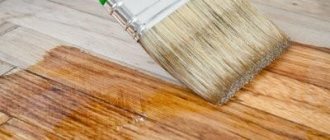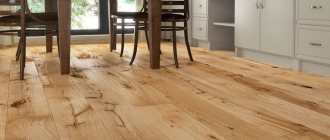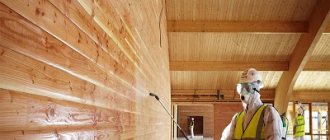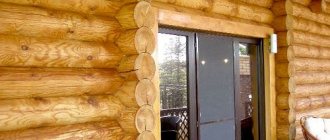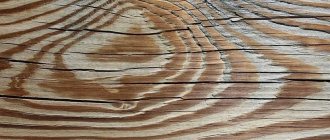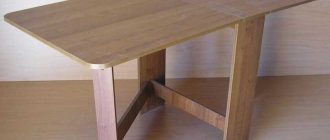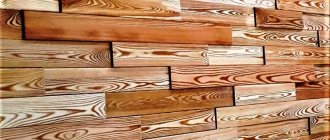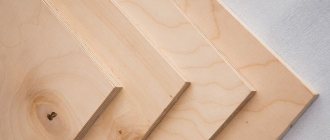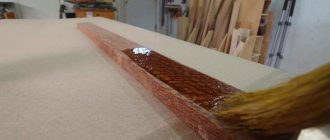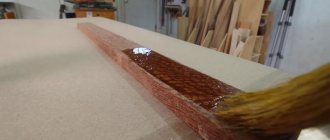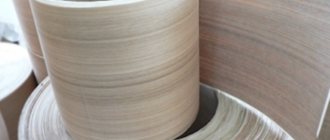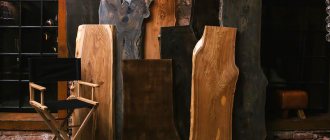| Place | Name | Characteristics in the rating |
| The best antiseptics for outdoor use |
| 1 | Tikkurila Valtti Expert Base | The best preparation for painting |
| 2 | Pinotex Natural | The most transparent impregnation |
| 3 | Dufa Wood Protect | Antiseptic with dirt-repellent effect |
| 4 | Pirilaks-Lux | Antiseptic with fireproof protection |
| 5 | Nortex-Disinfector | Comprehensive protection against biological damage and insects |
| The best antiseptics for interior work |
| 1 | NEOMID 400 | Maximum protection period |
| 2 | Senezh Ognebio Prof | Preservation of wood structure, fire resistance |
| 3 | Belinka Lasur/Belinka Lazur | Widest range of colors |
| 4 | Veres Classic Lazura | The best impregnation for a bath |
| 5 | Aquatex Extra | Versatility of use |
Despite the emergence of modern building materials, wood occupies one of the dominant places. To preserve all the best qualities of wood (even super-strong and elite), antiseptic treatment is required. Today, there are different compositions on the domestic market, both from domestic and foreign manufacturers. To choose the right wood impregnation, you should take into account several recommendations from experts.
- First of all, you need to pay attention to the scope of application. Some formulations are intended for internal use, while others are created for external use.
- The impregnation should not only effectively repel water, but also repel insects and suppress the proliferation of microorganisms. And if manufacturers add harmful chemical compounds to the composition for external use, then a modern product for internal use is made without organic solvents.
- It is very profitable to buy formulations that provide comprehensive protection. For example, there are products that protect wood from biological damage and from fire at the same time.
Our review includes the best wood preservatives. The rating was compiled taking into account the opinions of experts and reviews of Russian consumers.
Stage - whitening
If the wood is already affected by blue staining, the treatment of structures or building materials should begin with the use of a bleaching sanitizing composition PROSEPT 50 , which is a highly effective composition of active ingredients based on chlorine-containing compounds.
A 50% aqueous solution of PROSEPT 50 is applied with a brush or roller with synthetic bristles. Discoloration of pigment coloring, removal of fungi and mold, as well as the return of natural color to wooden products occurs within the first hour after application, while the structure of the wood is not disturbed. After a maximum of 24 hours, the preparation completely decomposes, so after the bleaching stage, if necessary, the wood must be antiseptic.
How to apply?
There are only two ways: using a brush/paint roller or spraying using special equipment. Painting with a roller or brush is more accurate, economical, but at the same time very labor-intensive. Therefore, it is better to spray the composition on large surfaces - the financial costs will be greater, but it will take less time. It may be necessary to apply the composition with a brush in some places.
Mistakes when processing wood yourself
Many owners of wooden houses think that if they process the wood themselves, they can significantly save on the services of specialists.
This is partly true; with self-processing, costs are limited only by the cost of materials. However, home craftsmen often make a number of mistakes, which have to be corrected by professionals. As a result, processing costs increase significantly.
When planning to process a house made of timber or logs yourself, you need to consider and avoid the following typical mistakes:
- violation of the technological process established by the manufacturer;
- failure to comply with the required temperature conditions;
- poor quality surface preparation or lack thereof;
- applying an insufficient number of layers of antiseptic.
If these and similar mistakes are made, it is impossible to achieve good processing quality and durability of the protective coating. After some time, a poorly processed house will look like the one in the photo.
If you want your home to receive long-term and reliable protection, entrust this work to specialists.
provides all types of services for antiseptic and finishing of wooden houses and baths. Our specialists are highly qualified, have extensive experience and work skills. For wood processing, we use only high-quality preparations that have all the necessary certificates. We are ready to take on work of any size and complexity.
To leave a request or contact us in another way, go to the “Contacts” page, where all the information about our company is located.
Calculate the cost of painting and insulating your home right now
Select types of work:
Select materials:
Criteria for choosing an antiseptic
To make the right choice of a suitable antiseptic, it is necessary to take into account the main criteria that determine the quality of the drug, the duration and effectiveness of its effect:
- Consumption rates of the protective composition (g/sq. m) when applied in one layer. The average consumption of wood antiseptics ranges from 180 to 260 g/sq.m. m. Fire retardants and bioprotection for wood have a high consumption - in this case the figure can be from 350 to 600 g/sq. m. For large volumes of work, it is recommended to calculate in advance the required amount of antiseptic composition. To do this, the total area of the treated surface in linear or square meters is taken into account.
- Required number of layers. Some types of antiseptics have a high consumption, so they are applied in 2-3 layers.
- Components of an antiseptic drug.
- Duration of validity of the protective agent. Wood antiseptics have a long service life, which can range from 2 to 7 years depending on their composition and quality. Any protective drug, under the influence of negative factors, gradually loses its original performance characteristics. Therefore, the period of 15-30 years declared by the manufacturer is nothing more than a marketing ploy.
- The need for additional drying and grinding of the treated surface.
- Available methods of applying impregnation are using a brush, roller or spray gun.
- Purpose - for residential buildings, baths, open and closed outbuildings, external and internal work.
- Compatible with decorative coatings - paint, varnish, stain and wax.
- Performance characteristics – resistance to weathering, ultraviolet radiation, biological contamination.
- The presence of special additives - coloring, protection against fire, rotting and destruction.
- Manufacturing company. Protective antiseptics for wood that meet all stated requirements are produced using specialized, expensive equipment that is available only to large companies. The high quality of the product is confirmed by the presence of relevant certificates and conclusions.
All the main parameters of the protective product are indicated by the manufacturer on the label, so it is recommended that you carefully study it before completing the purchase.
Best lists
Based on reviews from experienced users, we have compiled a list of the best wood preservatives in some categories:
- For external work.
- Mold protection.
- For old painted wood.
For external work
Veres Classic Lazura is the best wood impregnation agent. The main purpose is to work outside. The product itself is supplied for sale in aluminum cans of various packaging, allowing you to select the volume of the product based on the tasks at hand. It is colorless, thanks to which it retains the original color of the wood for a long time.
| Dilution | Not recommended |
| Shine | silky matte |
| Best before date | 5 years |
Price: from 400 to 780 rubles.
antiseptic Veres Classic Lazura
Mold protection
Dufatex is a colorless impregnation that is highly popular among buyers due to its environmentally friendly composition. It is made on a water basis, which ensures safety during use.
| Gloss | silky glossy |
| Number of colors | 6 pcs |
| Storage | in a cool dry place |
Price: from 1,200 to 2,600 rubles.
Dufatex antiseptic
For old painted furniture
Dufatex aqua is the best impregnation currently available for use on old painted furniture. Excellent for working on different types of wood. It is highly resistant to sunlight, sudden temperature changes and various types of precipitation.
| Gloss level | silky-glossy |
| Drying time | 10 o'clock |
| Tools | any |
Price: from 3,400 to 4,200 rubles.
Dufatex antiseptic
Types of antiseptic compounds
The construction market offers a huge number of different antiseptic agents, which are divided according to the following criteria - based on their basis, scope of use, functional features and cost.
To choose the right wood preservative, let’s take a closer look at each type.
The basis
All antiseptics have a different base, which is determined by the active components included in their composition.
The following categories of antiseptics are distinguished:
- water soluble
- oil,
- organic,
- combined.
Water soluble
Water-soluble antiseptics are intended for the prevention of any type of wood. Such compositions are suitable for impregnating various surfaces that are not directly exposed to excess moisture or water. The composition of water-soluble impregnations includes sodium fluoride and silicofluoride, boric acid and borax. They have a short drying time after application to the surface.
Oily
Oil-based antiseptics are the most popular because they are designed to protect wood from the negative effects of moisture. Non-washable impregnations are made on the basis of oils - anthracene, shale, creosote, coal and semi-coke.
Despite their effectiveness and good protection results, oil compositions are highly toxic, flammable and have an unpleasant chemical odor.
In addition, such impregnations can color wooden surfaces, giving them richer shades.
Organic
Organic-based antiseptics are used to impregnate structures and decorative elements inside and outside buildings. When applied, they create a durable, indelible film with excellent adhesive and hydrophobic properties.
Natural impregnations are developed for pre-treatment of modern lumber - timber, logs or boards used for the construction of walls.
The compositions color the wood green and increase its porosity, promoting the formation of corrosion on metal elements that are connected to the wooden base.
Combined
To produce combined formulations, a mineral base (salt) and an organic solvent are used, so they are able to perform the functions of antiseptics and fire retardants.
Such antiseptics provide reliable protection for wood from parasitic insects, mold, rotting and burning. In addition, some preparations contain safe coloring components, which, in addition to coloring, provide wood surfaces with maximum resistance to ultraviolet radiation.
Scope of use
The choice of suitable protective impregnation is determined depending on the type of wood and its purpose. According to the scope of use, antiseptics are divided into 2 categories:
- for external processing,
- for internal processing.
For outdoor use
Here are presented antiseptic compositions that are suitable for external wood treatment. They have excellent resistance to atmospheric influences - ultraviolet radiation, high humidity and temperature changes.
Antiseptics for external use have a strong chemical odor, which disappears after the treated surface has completely dried. Such preparations are not suitable for treating wood indoors.
Substances are divided into 2 types:
- Deep penetration impregnations are designed to destroy mold, fungi and pests.
- Finishing compounds are provided to protect the impregnating layer from wind load. They do not penetrate deeply into wood fibers, but are able to create a durable film on the treated surface.
For interior work
This includes antiseptic solutions based on environmentally friendly components, which are used to treat wood surfaces indoors. They have no chemical odor and do not release toxic substances into the air.
Deep penetration wood antiseptics have a prolonged effect and therefore do not require annual renewal.
For interior spaces with different humidity levels, it is necessary to choose appropriate antiseptic preparations. Information on the purpose of wood antiseptic is indicated on the original packaging.
